|
|
 |
|
Calanoida ( Order ) |
|
|
|
Diaptomoidea ( Superfamily ) |
|
|
|
Tortanidae ( Family ) |
|
|
|
Tortanus ( Genus ) |
|
|
|
Tortanus ( Sub-Genus ) |
|
|
| |
Tortanus (Tortanus) barbatus (Brady, 1883) (F,M) | |
| | | | | | | Syn.: | Corynura barbata Brady, 1883 (p.71, Descr.F, figs.F); Giesbrecht, 1892 (p.772);
Corynura denticulata Giesbrecht, 1889; Maiphae & Sa-ardrit, 2011 (p.641, Table 2, 3, Rem.);
Tortanus denticulatus Giesbrecht & Schmeil, 1898 (p.158); Shih & Young, 1995 (p.74); Tortanus sp. M Dakin & Colefax, 1940 [After Mulyadi, 2004, p.166] | | | | Ref.: | | | Giesbrecht & Schmeil, 1898 (p.158, Rem. F); A. Scott, 1909 (p.189, figs.F, Rem.); Sewell, 1912 (p.354, 377: Rem.); 1932 (p.399, Rem.); 1933 (p.29, Rem.); Früchtl, 1923 (p.456, Descr.M, fig.M, Rem.); Früchtl, 1924 b (p.15, 61, figs.F,M, Rem.); Steuer, 1926 a (p.61, figs.F,M, Rem., carte); Nicholls, 1944 (p.14, Rem.); C.B. Wilson, 1950 (p.345, fig.F); Kasturirangan, 1963 (p.66, figs.F); Goswami & Goswami, 1974 (p.109, fig. caryotypes); Greenwood, 1978 (p.18, figs.F,M, Rem.); Hulsemann, 1988 (p.656, Rem.); Ohtsuka, 1992 a (p.265); Kimmerer & al., 1985 (p.426); Bradford-Grieve, 1999 b (p.229, figs.F,M, Rem., figs.187, 195); Conway & al., 2003 (p.140, figs.F,M, Rem.); Mulyadi, 2004 (p.165, figs.F,M, Rem.); Phukham, 2008 (p.108, figs.F); Al-Yamani & al., 2011 (p.90, figs.F,M). | 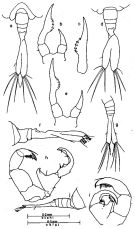 issued from : J.G. Greenwood in Proc. R. Soc. Qd, 1978, 89. [p.19, Fig.9]. Female (from Moreton Bay, E Australia): a, postrior metasome and urosome (dorsal); b, P5; c, aberrant left P5 with bifid denticle; d, posterior metasome and urosome with broad-caudal rami form (other specimen); e, P5 of same; f, posterior metasome and urosome of broad-caudal rami form (lateral left side). Male: g, urosome (dorsal); h, P5 (anterior view); i, P5 (posterior view); j, thoracis segments 4 - 5 and urosome (lateral right side). Nota: Variability in the nature of the comb of denticles on the inner margin of the female left P5, and of lateral setae on the caudal rami.
|
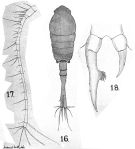 issued from : A. Scott in Siboga-Expedition, 1909, XIX a. [Plate LV, Figs.16-18]. Female (from Patany Bay: Siam): 16, habitus (dorsal); 17, A1; 18, P5.
|
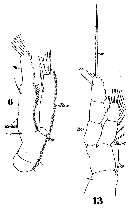 Issued from : W. Giesbrecht in Systematik und Faunistik der Pelagischen Copepoden des Golfes von Neapel und der angrenzenden Meeres-Abschnitte. – Fauna Flora Golf. Neapel, 1892. Atlas von 54 Tafeln. [Taf.31 , Figs.6, 13 ]. As Corynura denticulata. Female: 6, A2 (anterior view); 13, P1 (posterior view).
|
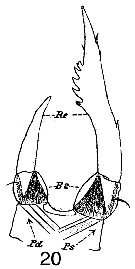 Issued from : W. Giesbrecht in Systematik und Faunistik der Pelagischen Copepoden des Golfes von Neapel und der angrenzenden Meeres-Abschnitte. – Fauna Flora Golf. Neapel, 1892. Atlas von 54 Tafeln. [Taf.31 , Fig.20 ]. As Corynura denticulata. Female: 20, P5 (posterior view).
|
 issued from : Y. Al-Yamani, V. Skryabin, A. Gubanova, S. khvorov & I. Prusova in Marine Zooplankton Parctical Guide for the Northwestern Arabian Gulf, 2, 2011 [p.91, Fig.227 c]. Female (from Kuwait): c, P5.
|
 issued from : Y. Al-Yamani, V. Skryabin, A. Gubanova, S. khvorov & I. Prusova in Marine Zooplankton Practical Guide for the Northwestern Arabian Gulf, 2, 2011 [p.91, Fig.228 c]. Male (from Kuwait): c, P5.
|
 issued from : Y. Al-Yamani, V. Skryabin, A. Gubanova, S. khvorov & I. Prusova in Marine Zooplankton Practical Guide for the Northwestern Arabian Gulf, 2, 2011 [p.91, Fig.228 c]. Male (from Kuwait): c, P5.
|
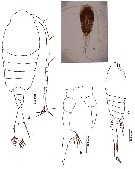 issued from : N. Phukham in Species diversity of calanoid copepods in Thai waters, Andaman Sea (Master of Science, Univ. Bangkok). 2008. [p.191, Fig.65]. Female (from W Malay Peninsula): a, c, habitus (dorsal and lateral, respectively); b, P5. Body length after the drawing: F = 1.430 mm.
|
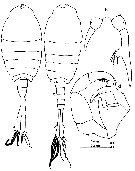 issued from : Mulyadi in Published by Res. Center Biol., Indonesia Inst. Sci. Bogor, 2004. [p.165, Fig.91]. Female (from Java): a, habitus (dorsal); b, P5. Nota: P5 asymmetrical; right leg 2-segmented, shorter than left one, exopodal segment (distal) short and naked; left leg long and stout, inner margin armed with a tuft of 5 curved lamelliform teeth at middle part. Male: c, habitus (dorsal); d, P5. Nota : A1 18-segmented, right side geniculate, anterior margins of segments 8 and 11 with row of small teeth, segments 13 to 15 with row of fine teeth, knee-joint between segments 14 and 15. P5: right leg 2-segmented, basal segment wider and triangular, provided with 2 finger-like process beset with nodulated protuberances and 1 seta; terminal segment strongly curved and arches over the first, bearing 4 small inner setae. Left leg with 1 basal and 2 exopodal segments, exopodal segment 1 with 1 outer seta; exopodal segment 2 (distal) with 2 small spines (1 near distal end and the other slightly posterior to it), 2 inner setae, and several distinct spinules near apex arranged in 7 or 8 semi-circular rows.
| | | | | Compl. Ref.: | | | Sewell, 1948 (p.324); Kott, 1957 (p.6, 15); Kimmerer & McKinnon, 1985 (p.149); Madhupratap & Haridas, 1986 (p.105, tab.1); Othman & al., 1990 (p.561, 564, Table 1); Gajbhiye & al., 1991 (p.189); Shih & Young, 1995 (p.74); Ramaiah & al., 1996 (p.3); Ramaiah & Nair, 1997 (tab.1); Mauchline, 1998 (tab.8); Greenwood & al., 2002 (p.17, Table 2); Rakhesh & al., 2008 (p.154, Table 5: abundance vs stations); McKinnon & al., 2008 (p.844: Tab.1, p.848: Tab. IV); Cornils & al., 2010 (p.2076, Table 3); Cornils & al., 2010 (p.2076, Table 3); Maiphae & Sa-ardrit, 2011 (p.641, Table 2, 3, Rem., as T. barbotus); Chew & Chong, 2011 (p.127, Table 3, abundance vs location); Johan & al., 2012 (p.647, Table 1, fig.2, salinity range); Varadharajan & Soundarapandian, 2013 (p.2: as Tartanus barbatus occurrence vs stations); Rakhesh & al., 2013 (p.7, Table 1, abundance vs stations); Jagadeesan & al., 2013 (p.27, Table 3, 5, fig.11, seasonal variation); Anjusha & al., 2013 (p.40, Table 3, abundance & feeding behavior) | | | | NZ: | 5 | | |
|
Distribution map of Tortanus (Tortanus) barbatus by geographical zones
|
| | | | | | | | | | Loc: | | | Red Sea, Arabian Gulf (Kuwait), Indian, Madagascar, India (Bombay, Burhabalanga estuary, Gulf of Mannar, Palk Bay, Godavari region, Kakinada Bay, Pointcalimere), Andaman Sea, Perai River estuary (Penang), W Malay Peninsula, Straits of Malacca (Sangga estuary, upper estuary to offshore), G. of Thailand, Indonesia-Malaysia, Java (Cilacap Bay, off Labuan, off Surabaya), SW Celebes, Aru (Philippines), Viet-Nam (Cauda Bay), China Seas (East China Sea, South China Sea), E & W Australia (S & E, Brisbane River estuary, Melbourne, SE, Shark Bay, North West Cape, G. of Carpentaria) | | | | N: | 42 | | | | Lg.: | | | (5) F: 1,6; (81) F: 1,43; (334) F: 1,43-1,36; (625) M: 1,12-1,05; (638) F: 1,44-1,32; (991) F: 1,25-2,1; M: 1,05-1,12; (1085) F: 1,15-1,5; M: 0,9-1,2; (1122) F: 1,59; M: 1,0; {F: 1,15-2,10; M: 0,90-1,20} | | | | Rem.: | Neritic, epipelagic.
Mulyadi (2004, p.166) points ro considerable confusion has occurred in this species in the past because of the variability in the nature of the comb of denticles on inner margin of female left P5, and the lateral setae of caudal rami. In Brady's (1883) figures the denticles terminated in long ''whips'' and the outer seta on the caudal ramus was long, reaching distal end of caudal ramus, in contrast to that of T. denticulatus. A. Scott (1909) first suggested synonymy of T. denticulaus and T. barbatus when he found intermediate forms in ''Siboga'' specimens, however Sewell (1912) in examining specimens from Bay of Bengal still considered that this distinct species, suggesting that Scott has mistaken T. denticulatus for T. barbatus. Früchtl (1924) analysed a large number of individuals and fully supported Scott's case for synonymy. This was accepted by Steuer (1926), and subsequently by Sewell (1932) recognizing that the denticles could vary from obtuse to elongate and whip-like, and a long seta may or may not be present on the midlateral margin of the right caudal ramus.. In both these respects the Moreton Bay material (Greenwood, 1978) is very uniform and agrees with the previous denticulatus end of the spectrum. All specimens examined had 5 distinct obtuse denticles no evidence of whip-like extensions, there were no setae arising from the lateral margin of right caudal ramus.
See in DVP Conway & al., 2003 (version 1) | | | Last update : 18/05/2018 | |
|
|
 Any use of this site for a publication will be mentioned with the following reference : Any use of this site for a publication will be mentioned with the following reference :
Razouls C., Desreumaux N., Kouwenberg J. and de Bovée F., 2005-2025. - Biodiversity of Marine Planktonic Copepods (morphology, geographical distribution and biological data). Sorbonne University, CNRS. Available at http://copepodes.obs-banyuls.fr/en [Accessed August 26, 2025] © copyright 2005-2025 Sorbonne University, CNRS
|
|
 |
 |











